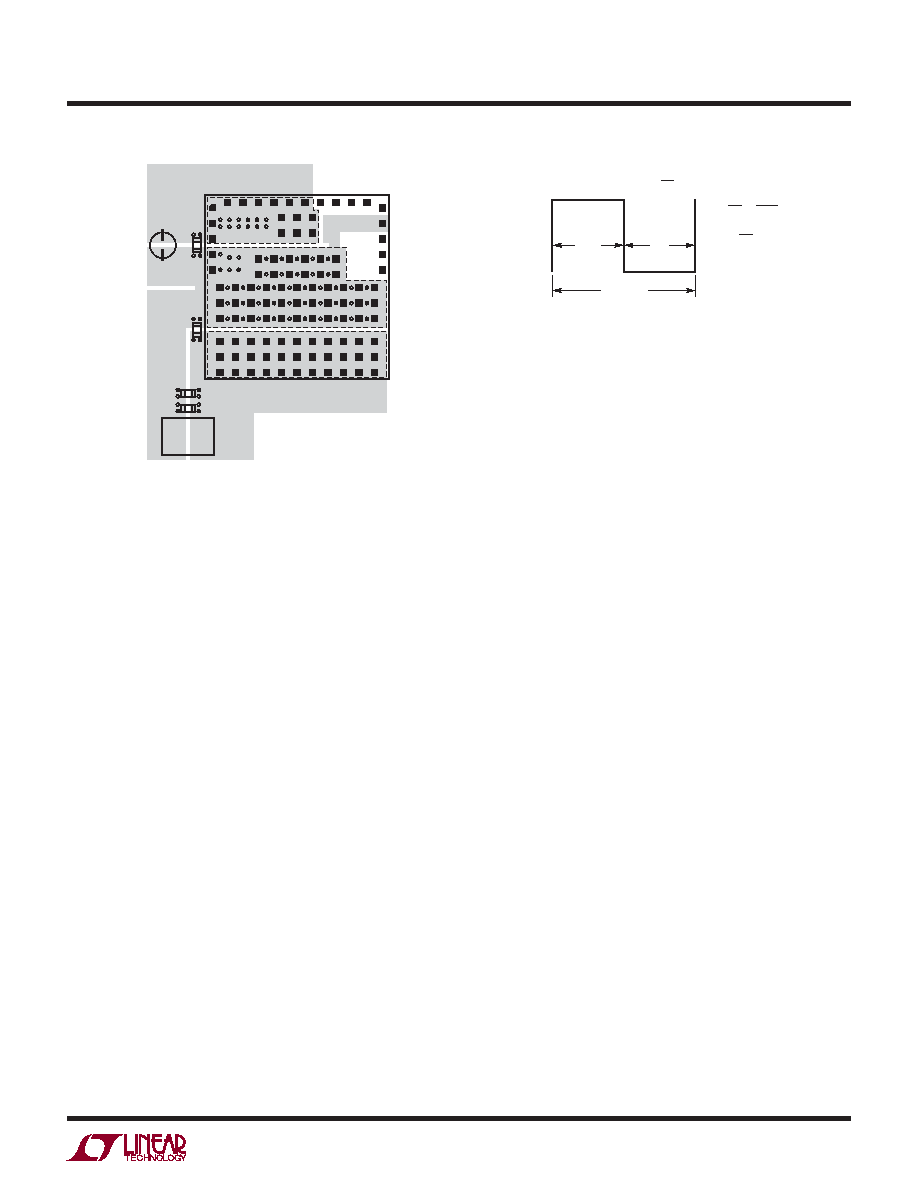
LTM4600HV
17
4600hvfd
Figure 20. Recommended PCB Layout
VIN
PGND
TOP LAYER
VOUT
4600hv F20
LOAD
CIN
LTM4600HV Frequency Adjustment
The LTM4600HV is designed to typically operate at 850kHz
across most input and output conditions. The control ar-
chitecture is constant on time valley mode current control.
The fADJ pin is typically left open or decoupled with an
optional 1000pF capacitor. The switching frequency has
been optimized to maintain constant output ripple over the
operating conditions. The equations for setting the operat-
ing frequency are set around a programmable constant on
time. This on time is developed by a programmable current
into an on board 10pF capacitor that establishes a ramp
that is compared to a voltage threshold equal to the output
voltage up to a 2.4V clamp. This ION current is equal to:
ION = (VIN – 0.7V)/110k, with the 110k onboard resistor
from VIN to fADJ. The on time is equal to tON = (VOUT/ION)
10pF and tOFF = ts – tON. The frequency is equal to: Freq.
= DC/tON. The ION current is proportional to VIN, and the
regulator duty cycle is inversely proportional to VIN, there-
fore the step-down regulator will remain relatively constant
frequency as the duty cycle adjustment takes place with
lowering VIN. The on time is proportional to VOUT up to a
2.4V clamp. This will hold frequency relatively constant
with different output voltages up to 2.4V. The regulator
switching period is comprised of the on time and off time
as depicted in the following waveform. The on time is
equal to tON = (VOUT/ION) 10pF and tOFF = ts – tON. The
frequency is equal to: Frequency = DC/tON).
The LTM4600HV has a minimum (tON) on time of 100
nanoseconds and a minimum (tOFF) off time of 400
nanoseconds. The 2.4V clamp on the ramp threshold as
a function of VOUT will cause the switching frequency to
increase by the ratio of VOUT/2.4V for 3.3V and 5V outputs.
This is due to the fact the on time will not increase as VOUT
increases past 2.4V. Therefore, if the nominal switching
frequency is 850kHz, then the switching frequency will
increase to ~1.2MHz for 3.3V, and ~1.7MHz for 5V out-
puts due to Frequency = (DC/tON) When the switching
frequency increases to 1.2MHz, then the time period tS is
reduced to ~833 nanoseconds and at 1.7MHz the switching
period reduces to ~588 nanoseconds. When higher duty
cycle conversions like 5V to 3.3V and 12V to 5V need to
be accommodated, then the switching frequency can be
lowered to alleviate the violation of the 400ns minimum
off time. Since the total switching period is tS = tON + tOFF,
tOFF will be below the 400ns minimum off time. A resistor
from the fADJ pin to ground can shunt current away from
the on time generator, thus allowing for a longer on time
and a lower switching frequency. 12V to 5V and 5V to
3.3V derivations are explained in the data sheet to lower
switching frequency and accommodate these step-down
conversions.
Equations for setting frequency for 12V to 5V:
ION = (VIN – 0.7V)/110k; ION = 103μA
frequency = (ION/[2.4V 10pF]) DC = 1.79MHz;
DC = duty cycle, duty cycle is (VOUT/VIN)
tS = tON + tOFF, tON = on-time, tOFF = off-time of the
switching period; tS = 1/frequency
tOFF must be greater than 400ns, or tS – tON > 400ns.
tON = DC tS
1MHz frequency or 1μs period is chosen for 12V to 5V.
tOFF
PERIOD ts
tON
4602 F25
(DC) DUTY CYCLE =
tON
ts
DC =
=
tON
ts
FREQ =
DC
tON
VOUT
VIN
APPLICATIONS INFORMATION